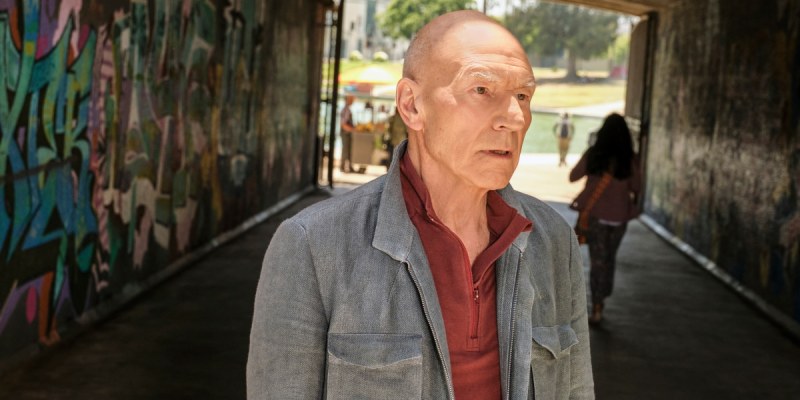This discussion and review contains some spoilers for Star Trek: Picard season 2, episode 4, “Watcher.”
With “Watcher,” Star Trek: Picard season 2 runs into a couple of significant issues.
For better and worse, both Discovery and Picard are versions of Star Trek that rely heavily on momentum. Despite what some nostalgic fans might argue, this is not an innovation of the Kurtzman era. Arguably, it traces its root back to Brannon Braga’s stewardship of Voyager. While Ira Steven Behr pushed Deep Space Nine to be more novelistic, Braga tried to guide Voyager towards a decidedly blockbuster sensibility on a contemporary television budget.
Braga was the architect behind epic mid-season two-parters like “Future’s End” and “Year of Hell” and effectively packaged two-part episodes like “The Killing Game,” “Dark Frontier,” and “Flesh and Blood” as two-hour television movies. It didn’t always work, but many of the best episodes of Voyager were designed to be propulsive high-stakes and high-concept spectacle, even standalone episodes like “Deadlock” or “Timeless.” With Voyager, Braga tried to embrace event storytelling.
There is a solid argument to be made that the breakneck pacing and occasional logical leaps that both Discovery and Picard make are an extension of Braga’s approach to Voyager. After all, however one might feel about Voyager, there is considerable evidence that the show has undergone something of a reappraisal in recent years. Picard even features Seven of Nine (Jeri Ryan) as a regular. So this momentum-driven approach to storytelling represents a clear evolution.

The second season of Picard has managed to build up enough momentum to keep itself upright, with the first three episodes speeding through a number of separate premises in quick succession. “The Star Gazer” set up the characters and the overall premise for the season. “Penance” threw the cast into a dark alternate universe. “Assimilation” threw the ensemble back in time. There was precious little time for the show to acclimatize to one setup before moving swiftly to the next.
The problem with “Watcher” is that it marks the first time that Star Trek: Picard season 2 slows down, and there’s a sense of lost momentum that feels somewhat strange in the context of an episode that features a gratuitous car chase through Los Angeles. “Watcher” doesn’t really introduce too many new concepts or ideas. It doesn’t pivot sharply from the setup in “Assimilation.” Instead, for the first time in the season, the characters are actually allowed to sit and assess.
This is a problem because it also allows some of the cracks to show. There are a variety of smaller issues with “Watcher” that build to critical mass to hint at bigger issues. There’s a strange moment during the car chase through Los Angeles in April 2024 that features a gigantic billboard for the April 2021 Netflix release The Mitchells vs. the Machines. It’s a small error, but it’s a distracting one. It’s frustrating that the shot couldn’t be framed to conceal the incongruous element.
Meanwhile, “Watcher” reunites Jean-Luc Picard (Patrick Stewart) with his old friend Guinan. Guinan has traditionally been played by Whoopi Goldberg, who reprised the role in “The Star Gazer.” However, rather than use computer-generated imagery to de-age Goldberg like the Star Wars franchise does, “Watcher” recasts Ito Aghayere in the role of Guinan’s younger self. It is probably a good call.

While Goldberg played a version of Guinan from 1893 in “Time’s Arrow,” it makes sense to cast a younger actor in the role who can give an actual performance rather than asking Goldberg and a team of technicians to try to modulate one through pixels. However, the reunion between Picard and Guinan in April 2024 in “Watcher” is distracting because Guinan doesn’t seem to remember Picard from their earlier encounter in “Time’s Arrow.”
The production team has been quick to clarify that this is not a continuity error. “Guinan does not recognize Picard and 2024,” a representative told Variety. “Fans might be briefly confused by this because she did meet him on Earth in 1893 in The Next Generation. The reason that she doesn’t recognize Picard is that he’s traveled from a future in which Starfleet doesn’t exist, and therefore the whole thing with Data’s head in ‘Time’s Arrow’ never happened.”
This is the sort of logic that Doctor Who cleverly writes off as “wibbly-wobbly, timey-wimey.” It’s also the kind of continuity gap that is excusable in time travel stories like this. When the crew of Star Trek: Voyager traveled back to contemporary Los Angeles in “Future’s End” in November 1996, Greg Cox’s later continuity wrangling aside, it seemed to directly contradict the history of the “Eugenics Wars” on 1990s Earth established in “Space Seed” back in February 1967.
However, in the larger context of the episode, it is distracting. It is not any one individual thing; it is the sense in which these smaller inconsistencies build upon one another. After all, one of the more frustrating aspects of “Watcher” is the sense in which the Star Trek universe has become so small and insular that Picard cannot get thrown back in time without meeting his old bartender Guinan and his old housekeeper Laris (Orla Brady). Publicity confirmed that Brent Spiner will also show up.

In some ways, this is the logical culmination of the sort of nostalgia that runs through the modern iterations of franchises like Star Trek or Star Wars, where the answer to every question must be assumed to be something that the audience already knows so as to assure them that their familiarity with the franchise has value. Ironically, in a small touch, Picard’s visit to Château Picard in the first act features a gun on a mantlepiece that doesn’t go off in the third.
It doesn’t help that Picard is never quite as smart as it thinks that it is. There’s a weird smugness to the second season, with “Watcher” dedicating a small scene to Rios (Santiago Cabrera) outlining the plot of the first season to an immigration official, only to conclude, “No one can explain it to me.” It feels like the second season is making a cheap joke at the expense of the first season, in a way that isn’t entirely earned. If anything, the second season’s internal logic is decidedly looser.
Similarly, the season’s character dynamics feel strange. The idea of developing a relationship between Jurati (Alison Pill) and the Borg Queen (Annie Wersching) is interesting, as is the idea of treating the Borg Queen as an imprisoned serial killer in something like The Silence of the Lambs or Mindhunter. The Borg Queen has always been a seductive figure and Jurati a decidedly ambiguous character, so there’s a nice tension there that recalls something like the underrated “Meld.”
However, the writing is simply not strong enough to support this idea. There’s something compelling in the idea that the Borg Queen is so desperate for communion that she will help Jurati in return for conversation, and there’s something equally clever in the idea that Jurati is every bit as cynical and manipulative. However, it just leads to nonsense dialogue like the Queen randomly stating, “Betrayal is just an anagram for ‘believe me.’” This is indicative of the show’s dialogue in general.

The result is that it’s hard to care about what is happening to these characters in these narratives. It is a shame because there are worthwhile ideas here. With Guinan as a “listener” and with Laris as the “watcher,” not to mention the religious connotations implicit in the Watchers seeing themselves as “guardian angels,” there are hints of subtext about the difference between observation and participation. There’s the idea that fixing the world requires action, not just attention.
There is something interesting in the gulf that Star Trek: Picard presents between the modern day and the utopian future presented in The Next Generation, with the ruins of Château Picard serving as a wonderful visual metaphor for how the modern world has let utopian thought decay and atrophy. “Change always comes later than we think it should,” Picard tells Guinan, a potent and timely idea. It’s also nice to see the show acknowledge the real-world abuses of organizations like I.C.E.
At the same time, there is perhaps something trite in the closing scene’s implication that such moral decline can be fixed by returning to space. “Will 2024 Revive Space Exploration?” asks the headline on Q’s (John de Lancie) newspaper, implying that mankind just needs to explore the cosmos to get its groove back. This plays into the worst tendencies of the Star Trek franchise, a technological determinism that largely ignores the underlying social issues that society needs to address.
With “Watcher,” Star Trek: Picard season 2 stumbles, revealing the cost of the momentum that drove the season’s first three episodes. Picard may have finally caught up with itself, but the show now finds itself tripping over the finer details.
